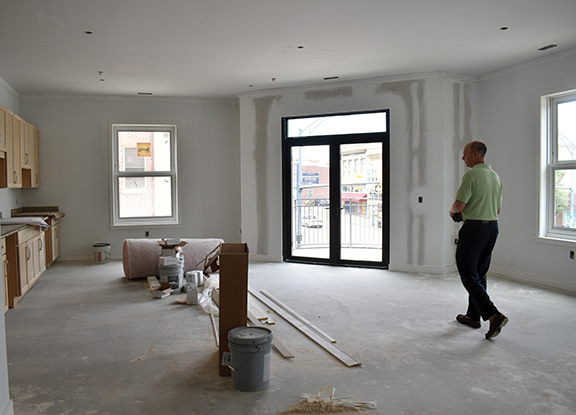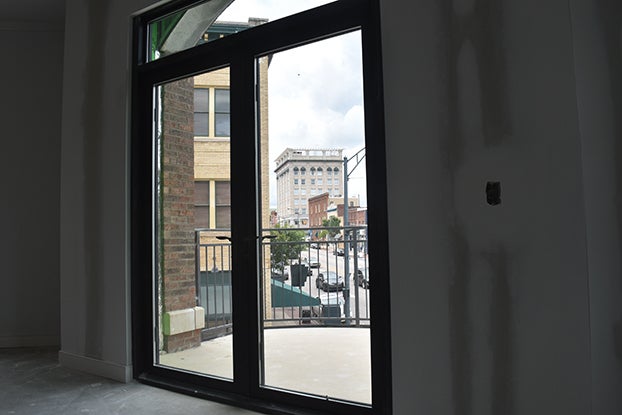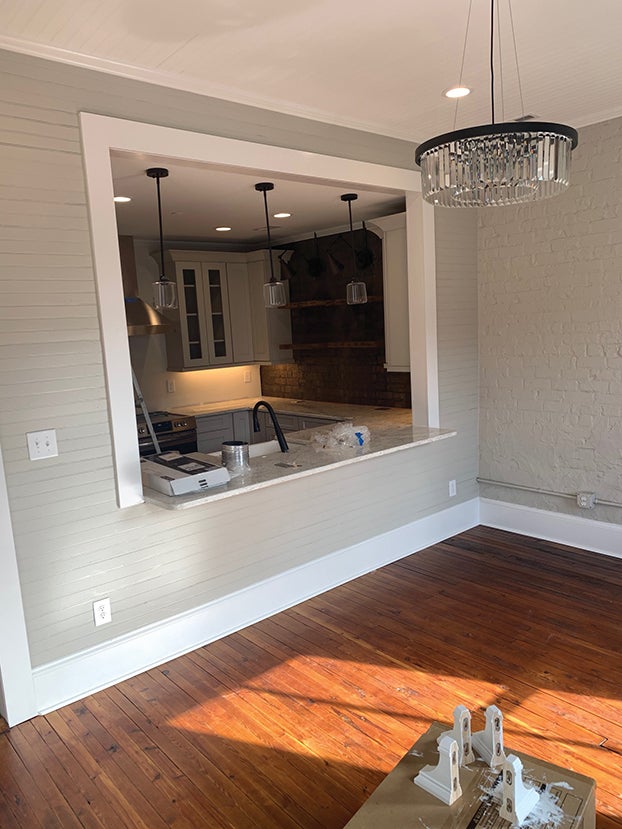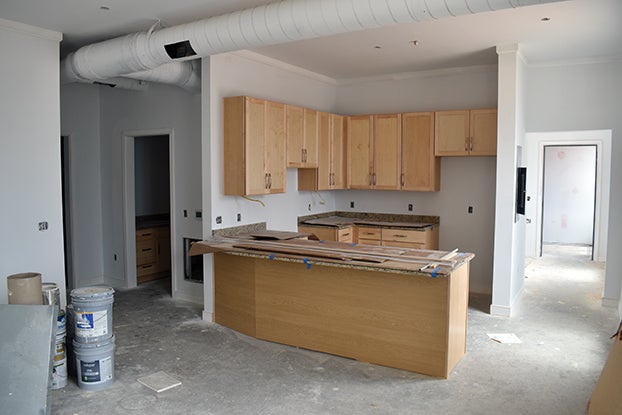Downtown Salisbury bullish on potential for more residential space
Published 12:01 am Sunday, June 13, 2021

- Pete Bogle walks through the unfinished living room of one of the five apartments located on the second floor of the new Bankett Station property at 201 E. Innes St. Ben Stansell/Salisbury Post
SALISBURY — As a graduate student at the University of North Carolina at Charlotte in the mid-1990s, Pete Bogle spent hours walking around downtown Salisbury, visiting every restaurant and store that would let him in.
“What I got to do back then, was I just came to town one day and met as many shop owners as I could,” Bogle said. “I asked them if I could go upstairs and see their space, see what was there.”
Bogle, who has since founded The Bogle Firm Architecture, was working on his thesis to become a master of architecture. The focus of his studies was to examine opportunities for residential living in the upper levels of downtown buildings.
“I think the occupancy rate for downtown Salisbury was over 90%, but that only counted the first floor,” Bogle said. “If you had a little bit of a shop in one corner of your first floor, that whole building was considered occupied, but what I started doing was a study on the total estimated square footage in all of the buildings and then how much of that was unused completely and underutilized and dead storage. That told a much, much different story.”
Although Bogle said his thesis was “unbuildable,” the conclusions of his work were promising.
“The findings of that thesis was that there was a huge amount of that potential for upper floor living,” Bogle said.
In the decades since Bogle wrote his thesis, downtown Salisbury has been working fo fulfill its potential. Downtown Salisbury’s residential living has grown to about 116 units. A study produced by the UNC School of Government presented to city council members last fall found downtown still has the capacity for an additional 90-130 multi-family residences.
While that may seem like a significant amount of units, Salisbury Community Planning Director Hannah Jacobson said the figure is realistic.
“Based on the number of calls I get almost weekly from people who are interested in investing, I think it’s achievable,” Jacobson said.
When Diane and Michael Young moved to the third floor of the Kluttz building overlooking the square in the 1980s, they were among a small group of people living downtown besides those in the Yadkin House Apartments. That changed when the Ketner family decided to invest in The Plaza Building.
“When we lived downtown, right after we moved into our apartment, a year or two after, the city worked with Ralph and Anne Ketner to do the Plaza project, so that infused 20 apartments in downtown Salisbury,” Young said.
Putting apartments in The Plaza Building, she said, was a turning point.
“When those apartments were built, the market was proven,” Young said. “Once you see that people do want to live downtown, it gets the private sector saying maybe renovating buildings and bringing apartments in would be a good investment. Because the city jumped on the residential model so quickly, I always knew downtown would have a fair amount of residential.”

The Plaza Building is visible from the balcony of one of downtown’s newest residential units on the second floor of the new Bankett Station building. Ben Stansell/Salisbury Post
As professionals who worked in downtown revitalization in various capacities, the Youngs saw the value in downtown living. That’s why they decided to invest themselves. They now own four units above The Smoke Pit and six in the O.O. Rufty Building across the street.
Developing those units for residential living, Young said, wasn’t cheap or easy.
“Next to a restaurant, it’s the most expensive type of construction you would undertake in an older building,” Young said.
Bogle, a downtown enthusiast who has worked on a number of multi-use projects, said renovating a historic property is oftentimes more expensive than simply constructing a building from the ground up.
In order to make residential units more cost-effective and spur more residential growth downtown, the city established the Downtown Revitalization Incentive Grant in 2014. The grant seeks to help smaller developers turn formerly vacant, historic spaces into new apartments that are compliant with the city’s building code, which typically requires specific fire suppression systems.
“It offers upwards of $150,000. Some people have been awarded that much over the years for projects that need certain standards,” Jacobson said. “That’s really important for gap financing, particularly for projects like historic downtown rehabs, which are always trickier and therefore riskier. It’s an important piece of the financing layer cake for a lot of smaller developers.”
The city grant program has been a tool used by downtown developers more frequently. In fact, with so many applications coming in, Jacobson said the structure of how the grant is awarded will likely change.
“A couple of years ago, it changed to where all the sudden the grants became competitive,” Jacobson said. “We had multiple projects that were very worthy projects, but we had a limited amount of money. The amount of grant money that was being requested far exceeded the amount we had budgeted. We know we’re going to need to do some revision to the program.”
Having an influx of applicants looking for funding, Jacobson said, is a wonderful problem to have.
“My ultimate goal is for downtown and for the grant program itself is to make the grant program obsolete,” Jacobson said. “That’s to say we get downtown to a place where the private market is incentive enough where we don’t need to provide incentives, where development makes sense because that’s what the private market tells them to do.”
In addition to the grants offered by the city, developers have also come to rely on historic rehabilitation tax credits provided at the state and federal level, which can include a 20% credit for qualifying rehabilitation of income-producing historic properties.

The sun shines in on the living room of one of the recently renovated apartment units on the second floor of the Barnhardt Jewelers building in downtown Salisbury. Photo submitted.
The two newest residential units developed downtown are above the renovated Barnhardt Jewelers store, but there are more projects currently in the works.
An additional five units located on the second floor of the new Bankett Station building 201 E. Innes St will soon be put on the market. The building, which will house Healthcare Management Consults on the first floor, was designed by Bogle’s firm. Bogle is also involved in a project to transform the second and third floors of the Bell Block Building into eight premium apartments. The project is a dream come true for Bogle, who put a picture of the Bell Block Building on his 1997 thesis.
“It’s just opportunity in the market,” Bogle said. “As an architect, I don’t get to push the market. I just get to respond to it and then guide clients in the best way forward. Getting to be here at the right time, that’s been a gift.”
Two groups are currently vying to develop the Empire Hotel property, which could feature several dozen residential units and single handedly push downtown closer to the residential capacity proposed in the UNC School of Government study.
Even as developers continue to add residential living, there are hurdles still facing multi-family units downtown. The biggest may be parking — a frequent topic of conversation, particularly after the Bell Tower Green Park’s development started, eliminating large parking lots.
David Post, a city council member, lawyer and owner of a strip of buildings in the first block of South Main Street, said a lack of parking has deterred development before.
“Parking is an issue,” Post said. “We’ve had businesses not come downtown and not make major investments because of lack of parking.”
Parking has been one of several reasons why Post hasn’t developed the upstairs space in the Oestreicher building into apartment living.
Bogle said many of the developers he’s worked with on residential properties downtown have keyed in on securing guaranteed parking. But Diane and Michael Young are an exception. The two property owners have practically ignored guaranteed parking for their residences, and have found success doing so.
“We’ve been renting apartments downtown for over 20 years,” Young said. “I think in showing our apartments, we’ve only lost one tenant I can recall due to the fact that they could not be guaranteed a parking space right near the building.”
Jacobson said parking will eventually have to be addressed in order for residential and other economic development to continue downtown.
“I think about parking a lot and particularly for the larger buildings downtown,” Jacobson said. “To really unlock their potential, there’s going to be off-street parking discussions and there have been a lot of discussions about off-street parking. Whether or not that’s in a surface lot or a deck somewhere, that is still being talked about.”

A view of one of the one-bedroom units on the second floor of the new Bankett Station building. There are three two-bedroom units and two one-bedroom units in the building. Ben Stansell/Salsibury Post
Parking is one of the factors that could affect downtown residential growth, but Jacobson said there are a few others as well. The development of Bell Tower Green, the completion of the city’s Downtown Main Street Plan and an increase in capacity for passenger rail along the Amtrak line to Charlotte could all be “catalytic” factors, she said.
Regardless of how quickly or how much residential growth continues to come downtown, Young said local businesses will benefit greatly.
“As we have gotten more residential in downtown since the 1980s, that has just supported the great number and diversity of eating establishments that we have, the breweries, the theater,” Young said. “It all fuels one another in terms of what residential living in downtown will do for a downtown.”




